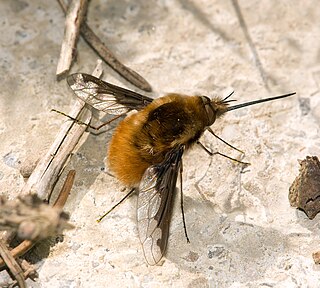
The Bombyliidae are a family of flies, commonly known as bee flies. Adults generally feed on nectar and pollen, some being important pollinators. Larvae are mostly parasitoids of other insects.

The Conopidae, also known as the thick-headed flies, are a family of flies within the Brachycera suborder of Diptera, and the sole member of the superfamily Conopoidea. Flies of the family Conopidae are distributed worldwide in all the biogeographic realms except for the poles and many of the Pacific islands. About 800 species in 47 genera are described worldwide, about 70 of which are found in North America. The majority of conopids are black and yellow, or black and white, and often strikingly resemble wasps, bees, or flies of the family Syrphidae, themselves notable bee mimics. A conopid is most frequently found at flowers, feeding on nectar with its proboscis, which is often long.

The Asilidae are the robber fly family, also called assassin flies. They are powerfully built, bristly flies with a short, stout proboscis enclosing the sharp, sucking hypopharynx. The name "robber flies" reflects their expert predatory habits; they feed mainly or exclusively on other insects and, as a rule, they wait in ambush and catch their prey in flight.
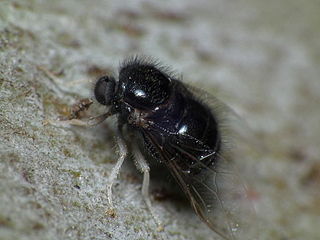
The Acroceridae are a small family of odd-looking flies. They have a hump-backed appearance with a strikingly small head, generally with a long proboscis for accessing nectar. They are rare and not widely known. The most frequently applied common names are small-headed flies or hunch-back flies. Many are bee or wasp mimics. Because they are parasitoids of spiders, they also are sometimes known as spider flies.

Bombylius major is a parasitic bee mimic fly. B. major is the most common type of fly within the Bombylius genus. The fly derives its name from its close resemblance to bumblebees and are often mistaken for them.
Heterostylum is a genus of flies belonging to the family Bombyliidae (bee-flies). There are 14 described species, distributed throughout the Americas. These are robust and very hairy flies with a body length of 10–15 mm. They can be distinguished from similar genera by an indentation in the hind margin of the eye and unique wing venation.

Hemipenthes is a large genus of flies belonging to the family Bombyliidae (bee-flies). There are many described species, distributed throughout the Holarctic realm. These are small to large robust flies with a body length of 5–14 mm. They can be distinguished from similar genera (Villa) by their wing venation. A number of species formerly in this genus were moved to a separate genus, ins in 2020.

Exoprosopa is a large cosmopolitan genus of flies belonging to the family Bombyliidae (bee-flies), with over 325 described species. The genus parasitizes a wide range of insects, including locust and larvae of wasps.

Balaana is a genus of flies belonging to the family Bombyliidae (bee-flies). There are about seven described species, including three from western Australia. These are robust and very hairy flies with a body length of 10–18 mm (0.4–0.7 in).

Exoprosopa jacchus is a species of 'bee flies' belonging to the family Bombyliidae subfamily Anthracinae.
Campsicnemus popeye is a species of carnivorous fly described in 2013. It was discovered from the Society Islands in French Polynesia. The species is named after the famous cartoon character Popeye the Sailor Man because of the enlarged tibia. The species is in fact among a group of six new species described as "Popeye flies". The specimen was collected in 2006 during an expedition to Tahiti.
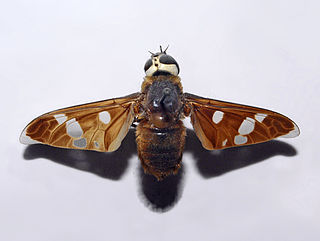
Hyperalonia is a genus of bee flies in the family Bombyliidae.

Villa modesta is a species of fly in the family Bombyliidae. The larvae may feed on larvae of Lepidoptera.
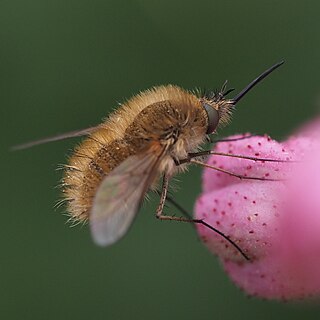
Bombylius canescens, commonly known as the western bee-fly, is a species of bee-fly belonging to the family Bombyliidae.

Bibio hortulanus, common name marchfly, is a species of fly from the family Bibionidae.
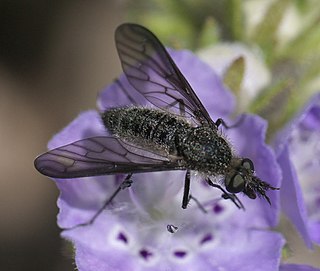
Bombyliinae is a subfamily of bee flies in the family Bombyliidae. There are more than 70 genera in Bombyliinae.

Brachyanax is a genus of bee fly in the subfamily Anthracinae. It was circumscribed by Neal Evenhuis in 1981. Thirteen species are recognized, and they are found in Asia and Australasia.
Hemipenthes webberi is a species of bee flies in the family Bombyliidae.
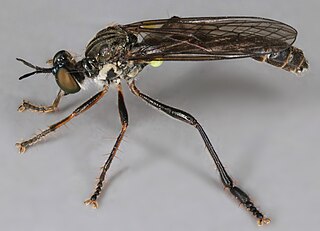
Dioctria hyalipennis is a Holarctic species of robber fly in the family Asilidae.

Tapeigaster argyrospila is a species of fly in the family Heleomyzidae. It is endemic to Australia, occurring in New South Wales, Queensland, South Australia, and Victoria.

















